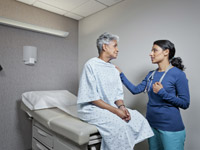Fruit juice cleanses are very hip theses days and as a Traditional Chinese Medicine practitioner, I'm not too crazy about them. First, juice is generally considered cold in TCM, which means many people can't digest it well, get stomach aches, and can have loose stools. Second, they are naturally sweet which can produce phlegm and phlegm can contribute to a wide number of health conditions including headaches, congestion, dizziness, weight gain, and well... phlegm!
There are many types of cleanses out on the market (protein powder based, soy, pre-mixed cleanses, fruit juice, plant juice), but of all of them fruit juice concerns me most because of the high amount of sugar you will be consuming. Taking in all that juice will spike your blood sugar, which in turn raises your
insulin production so your body can either use up the sugar for energy (but most likely won't in the case of a cleans because you will be taking in much more sugar than you need) or store it as fat.
Below is a great short article with some insight about what your body goes through when you are on an eight day juice cleanse. Enjoy and drink your juice sparingly =)
(I love to drink a little bit of pure dark cherry juice after a workout as a natural anti-inflammatory)
______________________________________________________________________________________________________________
How a Fruit Juice Cleanse Affects Your Body
Stripped of essential nutrients, detox diets can be downright dangerous
By Laura Beil, Photography By Dan Forbes
Thinking of signing up for a fruit juice cleanse?
You might first consider how your body reacts to a week with no protein
or fat and fewer than 1,000 calories a day.
After the first sip
Your brain's hunger signals are answered with a dump of pure fruit-juice sugar. And don't get any ideas—veggie-based
body cleanses aren't any healthier.
The sweet stuff prompts the pancreas to squirt out insulin, which
moves sugar—now in your blood in the form of glucose—into your cells.
After 30 minutes
As your cells suck up the glucose, your blood sugar level can start to plummet and you may feel dizzy.
Meanwhile, lacking enough calories, your body is operating off its
supply of glycogen, a form of short-term energy stored in the liver and
muscles.
After two days
With each shot of juice, your insulin levels skyrocket, then crash. Your
glycogen stores are pretty much gone, leaving your tank on empty—and
you feeling weak and listless.
Since you're getting only about half the calories you need, your body
draws on two long-term power sources: triglycerides, a type of energy
stored in fat cells (woo-hoo!), and protein, taken straight from your
muscles (oops). You begin to lose muscle mass, even if you're still
exercising every day.
After three days
Your brain is not happy. It enters into semi-starvation mode and gobbles
ketones, fuel that comes from the breakdown of fat. Ketones work, but
they're like low-grade gasoline; as a result, you may feel unfocused or
irritable. (Any "mental clarity" is likely due to a strong placebo
effect.)
Sans a fresh protein infusion, your brain is also lacking amino
acids, the raw materials that neurotransmitters need to maintain your
mood. If you're prone to depression, you may start feeling blue.
The proteins in your shrinking muscles break down into ammonia and
uric acid, unwelcome chemicals that invade your bloodstream. Now your
kidneys are busy detoxing your detox.
Stay near the bathroom: The juice's high carbohydrate load causes a
surfeit of water to enter the intestines. That extra H2O in your gut
means you're apt to get diarrhea.
After four days
With no food to digest, your small intestine feels ignored. Its
villi—the rows of tiny fibers that move food elements into the
blood—start to atrophy. Your diarrhea may get worse, leading to
dehydration... and there goes your rosy glow.
On the eighth day
Solid food! But uh-oh—you've lost muscle. Even if you go back to your
regular eating habits, you now have less muscle mass to burn those
calories; instead, the calories are more likely to be turned into fat.
(Hence, one reason yo-yo dieting makes it harder to lose weight: Your
reduced muscle-to-fat ratio messes up your metabolism and makes calories
much harder to work off.)
Sources: Eric Ravussin, Ph.D., Nutrition Obesity Research Center,
Pennington Biomedical Research Center; Timothy D. Brewerton, M.D.,
Medical University of South Carolina; Leslie P. Schilling, R.D.,
Schilling Nutrition Therapy; Lona Sandon, R.D., and Jo Ann S. Carson,
Ph.D., R.D., University of Texas Southwestern Medical Center at Dallas









.jpg)

